Mastering Downwind Sailing Techniques and Strategies
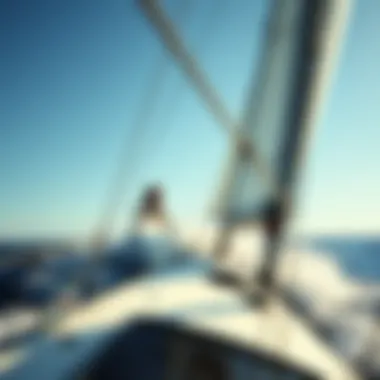
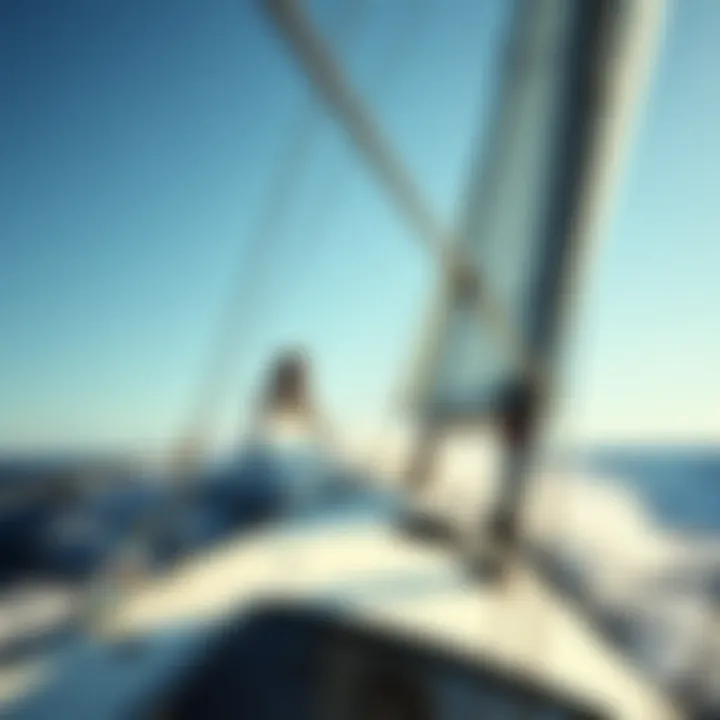
Intro
Sailing downwind can feel like catching the wind in your sails, but there’s more to it than just hoisting the mainsail and letting go. Understanding the art of downwind sailing means grasping a fine mesh of techniques, boat dynamics, and environmental nuances. Whether you're a greenhorn wanting to avoid a face-plant in the waves or a seasoned sailor looking to fine-tune your skills, this guide is designed to deepen your knowledge and improve your performance.
Feeling the rush of wind propelling you forward while the boat glides effortlessly can be intoxicating, yet the reality is that effective downwind sailing requires finesse and practice. Each decision on sail trim leads to different outcomes, and external factors, like weather patterns or sea conditions, can easily throw a wrench into your plans. The duel with nature has its charm, but it's crucial to be well-equipped with the right knowledge and techniques to navigate these adventures smoothly.
This article dives deep into the essential aspects of downwind sailing, breaking it down into manageable parts. We will explore the significance of sail trim, analyze how boat dynamics function under varying conditions, and provide practical tips that cater to sailors at all levels. By digging into these topics, we hope to pass some wisdom that can enhance your sailing experience. Let's hoist the sails and set our course!
Understanding Downwind Sailing
Sailing downwind is more than just a simple course; it represents a specific art form that combines understanding with practical skills. For both novice sailors and seasoned mariners, grasping downwind sailing dynamics is crucial. When you catch a favorable breeze and align your boat accordingly, it transforms your sailing experience from typical to exceptional.
By understanding the nuances of downwind sailing, you unlock several advantages. You can optimize speed, efficiency, and control, ensuring a smoother ride. Moreover, it empowers you to predict and manage challenges that may arise on the water—like sudden gusts or shifts in wind direction.
This section sets the stage for examining key elements such as sail adjustments, boat dynamics, and environmental conditions. Every sailor can benefit from honing their skills in this area, not only refining technique but also increasing enjoyment on the open seas.
Defining Downwind Sailing
Downwind sailing occurs when a vessel sails with the wind directly behind it. This situation can seem straightforward at first glance, yet it encompasses a range of variables that serious sailors must consider. The primary defining characteristic here is the ease of harnessing wind energy, allowing your boat to glide with less effort compared to beating against the wind.
It's vital to recognize that downwind sailing is not merely about sailing directly away from the wind. Sailors often take various angles to optimize their course, making it a strategic dance with nature. Understanding these angles and how they affect speed and stability can make the difference between a mediocre and an exceptional voyage.
Another critical aspect is sail trim. Proper sail adjustment can significantly enhance performance, allowing for better speed and control. Experimenting with the angle of the sails while monitoring boat movement will yield better insights into fine-tuning techniques for this style of sailing.
The Physics of Sailing with the Wind
To truly appreciate downwind sailing, one must grasp the underlying physics that govern it. Wind, when it interacts with the sails, creates lift, much like how airfoil wings work in aviation. When the wind flows over the surface of the sails, it generates a difference in pressure; this difference is what propels the boat forward.
Aspects such as lift and drag become crucial in downwind sailing. Lift at the sails must exceed the drag against the hull for an effective performance. Thus, understanding how to balance these forces becomes a fundamental aspect of skillful sailing.
To illustrate this:
- Lift helps to push the boat forward.
- Drag opposes this motion, causing the boat to slow down.
Managing these forces effectively can mean the difference between zipping along like a knife through butter and slogging in slow motion.
Furthermore, environmental conditions such as varying wind speeds can affect how well you harness that physics. Simply put, the more skilled you are at reading the wind, the better your downwind sailing experience will be.
"To sail is to be in tune with the wind, listening in harmony to nature's voice, guiding your journey."
In taking the time to understand these concepts, you build a solid foundation for practical application later, which will be explored in more depth throughout the article.
Sailboat Dynamics During Downwind
When it comes to sailing downwind, understanding the sailboat dynamics is crucial. This aspect touches on how a sailboat interacts with the wind and water, dictating not only speed but also safety and maneuverability. Without grasping these dynamics, a sailor could easily find themselves in precarious situations, whether caught in a sudden gust or struggling to maintain a straight course. Sir Isaac Newton might have had a few things to say about forces and motions, but sailing relies on bringing that theory down to earth—or rather, across the water.
Here’s what to consider:
- Speed and Direction: During downwind sailing, the sailor must aim for optimal speed while ensuring they do not veer off course. It’s a tightrope walk between efficiency and control.
- Balance and Stability: Knowing how to shift weight effectively on the boat can make a world of difference in achieving stability.
- Equipment and Setup: The right gear plays an undeniable role in how a sailboat behaves—everything from sail size to the position of the rudder.
The next few sections will dissect these vital components further, focusing specifically on two key areas: the role of sail area and shape, and the center of lateral resistance.
The Role of Sail Area and Shape
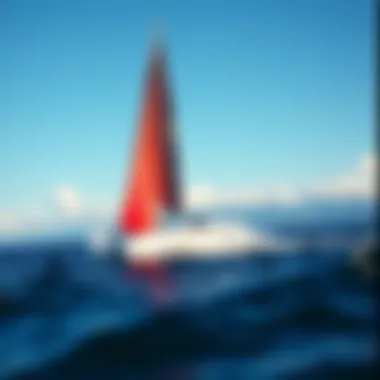

Sail area and shape directly influence performance when sailing downwind. Think of the sail as a big, powerful bucket that catches the wind. The bigger the bucket—up to a point—the more wind it can catch and the faster you can go. However, sail shape is just as important as size.
- Surface Area and Lift: A larger sail area can catch more wind, allowing quicker speeds—but if a sail is too large for the boat, it can cause the vessel to heel excessively or even capsize.
- Sail Shape Adjustments: The shape of the sail affects airflow. A full sail creates more lift; a flatter sail can help maintain control in higher winds.
To make good use of sail area, sailors should be able to adjust their sails to suit conditions. A poorly configured sail can become a flag rather than a driving force; not what you want when you’re trying to surge ahead.
Adjusting for Conditions
An effective sailor distinguishes when to shape their sails and by how much. This involves a keen understanding of weather forecasts, body swells, and even other boats nearby.
- Light Winds: In a lighter breeze, you might favor fuller sails to maximize lift.
- Strong Gusts: Conversely, reducing the sail area by using a reefing technique or flattening the sails might be smart to avoid overpowering the boat.
Understanding Center of Lateral Resistance
The center of lateral resistance (CLR) is another hidden gem in the world of sailing. It’s the point in the hull of the boat that opposes lateral forces from the sails. Think of CLR as the counterbalance to the forces generated by the wind acting on the sails.
- Balancing Forces: The CLR works alongside the center of effort (CE) of the sail. When these two points are in harmony, the boat moves efficiently through the water. When they misalign, however, it creates drift, making handling that much more difficult.
- Impact of Hull Shape: The shape of the hull affects the CLR. A long, narrow hull will have a different CLR than a wide, flat one, which can significantly impact how the boat responds downwind.
Having knowledge of CLR allows sailors to anticipate how shifting wind can influence their trajectory. Ignoring it can lead to unexpected slips or, worse, capsizing.
"Sailing downwind is as much about understanding the invisible forces around the boat as it is about handling the physical controls on board."
In summary, understanding sailboat dynamics during downwind sailing revolves around the interplay of sail area, shape, and the center of lateral resistance. Taking control of these factors can provide the wind at your back and ensure a smooth ride. Proper adjustments can lead to optimal performance, making the experience not only safer but also more enjoyable.
Techniques for Effective Downwind Sailing
Sailing downwind presents a unique set of challenges and opportunities that require a nuanced understanding of techniques related to sail control and boat dynamics. The effectiveness of these techniques can drastically influence sailing performance. A sailor's ability to harness the wind effectively while managing sail adjustments creates a balance that maximizes speed and stability. This section will review important strategies for optimizing downwind sailing.
Sail Trim Adjustments
Sail trim is often regarded as the heart of effective downwind sailing. When you're sailing with the wind at your back, the way you set your sails can mean the difference between a leisurely drift and a thrilling ride. Adjusting the sail trim appropriately allows your vessel to catch as much wind as possible without risking a dangerous broach, where the boat tips excessively to one side.
It’s crucial to keep in mind that the sail’s shape must adapt to the wind conditions. For instance, you may want to let the sails out more when the wind is blowing steadily. Conversely, in lighter winds, pulling the sails slightly in can help to create better shape, aiding performance.
Here are key points to consider for sail trim adjustments:
- Ease the mainsail and headsail: This provides maximum power and lets the sails catch the wind more effectively.
- Watch for telltales: Using small ribbons attached to the sail, these indicators tell you if the sails are aligned properly with the wind flow. If the telltales are fluttering or not streaming back, it's time to make adjustments.
- Use the boom: Positioning the boom correctly can also help optimize sail shape. Angle it outwards but be cautious not to let it swing uncontrolled.
In summary, keeping an eye on sail trim not only enhances speed but also brings about a more enjoyable sailing experience.
The Use of Spinnakers in Downwind Conditions
In any sailor's toolkit for downwind conditions, the spinnaker stands out as a versatile sail that can amplify performance when conditions are right. Spinnakers are huge, colorful sails designed specifically for sailing downwind and catching the breeze. They transform downwind sailing into a more exhilarating endeavor, allowing vessels to capture more wind and sail faster.
However, embracing the spinnaker isn’t just about hoisting it up. Proper technique and understanding its behavior in varied wind conditions is essential:
- Hoisting the spinnaker: Ensure that your crew knows when to raise this sail, ideally as you turn downwind. A coordinated effort is key, as a poorly timed hoist can lead to a wrap or tangling.
- Control the sheet: Just as with regular sails, how you control the spinnaker sheet can significantly impact your speed. By pulling the sheet tighter in lighter winds and allowing it to fly a bit freer when gusts appear, you can maintain optimum performance.
- Gybing: As you change direction, it’s vital to manage the spinnaker carefully to avoid collapse. Practice makes perfect, allowing for smoother transitions that keep the sail full.
Using spinnakers does require practice, but once mastered, they open up new horizons and can transform ordinary downwind passages into thrilling surges of speed.
Dealing with Gusts and Lulls
In the unpredictable world of sailing, understanding how to deal with gusts and lulls becomes paramount. Wind conditions are anything but linear; they shift and change, creating a dynamic environment that can throw even seasoned sailors off their game. Gusts can come barreling down, filling your sails with sudden force, while lulls leave your boat feeling like it’s treading water.
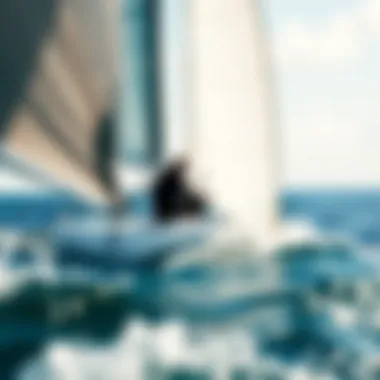
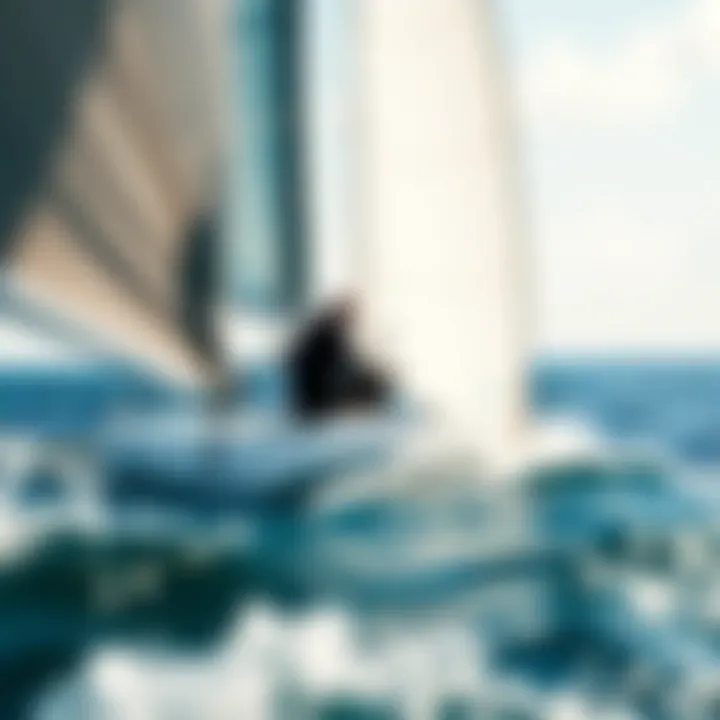
To maintain control and optimize performance in these conditions, consider the following:
- Anticipation: Keeping a close eye on the clouds and water surface can provide visual cues about changing wind patterns. Being prepared to react is half the battle.
- Adjustment: When a gust strikes, swiftly easing the mainsail and headsails can help prevent overpowering the boat. Conversely, when you find yourself in a lull, inboard sail adjustments might help maintain momentum.
- Balance the boat: Keeping the boat balanced, perhaps by moving crew weight, can make a world of difference during gusts. Keeping sharp attention to weight distribution during these changes will go a long way to reduce the chances of heeling excessively.
Environmental Factors Affecting Downwind Sailing
Understanding the interplay of environmental factors when sailing downwind is crucial for safe and efficient navigation. These factors dictate the movement of the sailboat, influencing speed, direction, and overall performance. By grasping how wind patterns, water currents, and wave interactions come into play, sailors can make informed decisions that enhance their sailing experience.
Wind Patterns and Behavior
Wind is the lifeblood of sailing. When it comes to downwind sailing, understanding wind patterns is not just beneficial; it’s essential. Winds are not static. They can shift in direction and intensity based on various environmental influences such as topography, temperature, and barometric pressure.
A key point to remember is that wind often behaves differently near land compared to open water. You’ll notice that coastal areas may experience sea breezes, which can shift dramatically throughout the day or due to surrounding terrain. For example, if you’re sailing near a cliffside, expect the wind to funnel and possibly increase in strength as it moves down toward the water.
"Understanding local wind patterns is akin to reading the ocean's heartbeat; it's the secret weapon for the savvy sailor."
Sailors should also monitor phenomena like gusts. These sudden bursts of wind can catch an unprepared sailor off guard. Anticipating gusts involves observing the water surface and environmental indicators. For instance, choppy water may signal wind strength variations ahead. Adjusting the sail trim just before encountering a gust can help maintain control and maximize speed.
Understanding Current and Wave Interaction
Just as wind patterns affect sailing, water currents play a significant role too. Currents can easily complicate the downwind journey. Sailors need to be conscious of how they interact with the wind and waves. A current can either help or hinder your progress, depending on its direction and strength.
When you sail downwind, the motion can create a confusing visual landscape. Waves generated by a strong current can alter your course or the way your boat reacts. For example, a current pushing against the wind can create chaotic sea conditions, leading to unpredictable wave patterns. Learning to read waves is almost like developing a sixth sense; you start to feel when to brace for impact or adjust the sails.
Here are several things to consider when it comes to currents:
- Direction: Always observe the current’s flow. Is it working with you or against you?
- Speed: Changes in current speed might indicate deeper water or shallows ahead.
- Interaction with Wind: Steady winds might create larger waves in combination with strong currents, demanding more technical sailing skills.
By becoming adept at recognizing how currents and waves can work together or against each other, you can significantly improve your downwind sailing proficiency.
Strategic Considerations for Downwind Courses
Strategic considerations when sailing downwind are pivotal to enhancing performance and ensuring safety. When sailors embrace these elements, they can make informed decisions that significantly affect their sailing experience. This section sheds light on how to maximize efficiency and navigate challenges encountered during downwind sailing.
Choosing the Right Course Angle
Selecting the optimal course angle is akin to choosing the right path in a maze; a slight miscalculation can lead to unnecessary detours or worse, capsize. The right angle between the wind direction and your boat can deliver either slick performance or sluggish progress.
When sailing downwind, sailboats should ideally operate at a beam reach or a broad reach. The reasoning lies in how a boat generates speed and power. On a beam reach, there is an ideal balance between wind pressure on the sails and the boat's natural stability. Here are a few key advantages of mastering the right course angle:
- Speed Optimization: A directly downwind course can result in less speed due to the reduced effectiveness of sails. Experiment and find the sweet spot where the boat glides without oversteering.
- Reduced Heeling: When the sail is adjusted 90 degrees to the wind, the hull stays much steadier. Less heel translates to a safer and more enjoyable experience.
- Better Control: Sailing at an angle reduces the chance of having to constantly course-correct, allowing for more focus on potential hazards.
To choose your angle wisely, pay attention to the wind’s direction. Analyzing how shifts in wind can affect your sail angle allows for better adaptation on the water. Additionally, look out for signs in the water indicating shifts in breeze.
Navigating Obstacles and Changing Conditions
In the open arms of the ocean, sailors often confront surprises that can steer them off course—be it sudden gusts, rogue waves, or obstructive debris. Navigating obstacles and adapting to changing conditions forms the backbone of safe sailing.
When planning your downwind course, it's essential to visually scan the surroundings, looking not just for visible obstacles but also keenly observing the behavior of the water itself. For instance,
- Watch for Changes in Water Color: This can signal variations in depth, suggesting hazards lurking below.
- Identify Wind Shadows: Structures, islands, or other boats may cast shadowed areas of calm, altering wind dynamics suddenly.
- Monitor Weather Patterns: Even a few cloud formations can hint at impending gusts or shifts.
Additionally, possessing a keen sense of timing is crucial. Sudden shifts in wind are much like late freight trains; you’ve got to be aware and prepared.
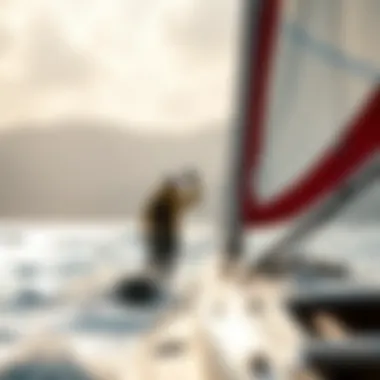

As you sail, practicing evasive maneuvers should be second nature. Always maintain a plan B for swift course adjustments to prevent any nasty surprises. Through this vigilance, you'll not only protect yourself and your crew but also get the most out of your downwind sailing experiences.
"Success in downwind sailing is not just in speed but also in the ability to anticipate and respond to changing conditions. A poised sailor wins the race."
In summary, strategic considerations when sailing downwind are vital. They ensure that sailors can maneuver efficiently, adapt to environmental changes, and navigate around obstacles safely. Understanding the nuances involved empowers every sailor to enhance their performance on the water, paving the way for enjoyable and successful voyages.
Safety Considerations When Sailing Downwind
Sailing downwind can be thrilling, but it’s not without its risks. Understanding safety considerations plays a critical role in ensuring a safe and enjoyable experience on the water. This part of the journey is not just about hoisting sails and feeling the wind in your hair; it’s about knowing how to protect yourself and your vessel against potential dangers that may arise.
Whether you’re an experienced mariner or still finding your sea legs, overlooking safety measures can lead to unfortunate consequences. Therefore, keeping a strong focus on safety prevents mishaps that can ruin your day out on the waves.
Equipment and Gear for Safety
Equipping your sailboat with the appropriate safety gear is akin to donning your seatbelt before hitting the road. This equipment can be a lifesaver, especially during downwind sailing when gusts and sudden changes in wind can catch even the most seasoned sailors off guard. Here’s a rundown of essential safety gear:
- Life jackets: Always wear a personal flotation device (PFD). It should be Coast Guard approved and fit well.
- First aid kit: Be sure to have a stocked maritime first aid kit on board. It should include antiseptic wipes, band-aids, and any medications you might need.
- Communication devices: A VHF radio is a must for emergencies, allowing you to communicate with shore stations or other boats. Additionally, a mobile phone in a waterproof case adds an extra layer of reassurance.
- Fire extinguisher: Make sure this is easily accessible and properly maintained, especially in case of an emergency.
- Flares and distress signals: These are vital for alerting other vessels and coast guard in case of need. Ensure they are within expiration date.
- Tool kit: Onboard repairs can sometimes be necessary. A basic toolkit can help in managing minor issues that may arise.
Implementing these safety measures isn’t just about legal compliance; it’s about ensuring a sense of security while you explore the open waters.
Recognizing and Responding to Hazards
Just as a seasoned traveler learns to navigate the labyrinths of unfamiliar cities, a sailor must develop an awareness of the hazards present on the water. These can include sudden wind shifts, obstacles in the water, or even other boats in close proximity. Knowing how to recognize these dangers is paramount to maintain control and prevent accidents.
- Wind shifts: Understand that wind can change directions unexpectedly. Look for visual cues on the water's surface, such as ripples or changes in wave patterns. These indicators can inform you of changing conditions.
- Obstacles: Be on the lookout for items like buoys, sandbars, or other vessels. Not all areas are clear, and some may present unexpected challenges.
- Weather changes: Darkening skies or shifting winds can signal approaching storms. Always check the forecast before heading out and stay vigilant during your sail.
Upon recognizing a potential hazard, a sailor must be ready to respond swiftly. Here are some immediate actions one might consider:
- Change course: If you spot an obstacle or boat suddenly appearing close by, adjust your heading to maintain a safe distance.
- Reduce sail area: If the wind begins to pick up unexpectedly, consider reefing your sail to lower the risk of capsizing.
- Communicate: Use your VHF radio or signals to alert other boats of your intentions when navigating around hazards.
Having the knowledge and foresight to recognize these challenges empowers a sailor to maintain not just control of their vessel but also their peace of mind as they sail downwind.
"Seafaring isn’t just a skill; it’s a dance with nature, requiring not just technical proficiency but also a keen sense of situational awareness."
By placing emphasis on safety considerations, sailors can focus on the joy of sailing while mitigating risks, allowing for a more rewarding experience on the open water. For further information on safety protocols while sailing, consider checking out guides provided by the U.S. Coast Guard at uscg.gov or resources from local sailing organizations.
The Future of Sailing Downwind Techniques
Sailing downwind represents a unique blend of art and science. As the maritime world evolves, innovative techniques and technologies are paving the way for enhanced efficiency and safety on the water. Understanding these advancements can not only elevate your sailing experience but also ensure that you stay ahead of the curve in an increasingly dynamic environment. The future of downwind sailing is an exciting subject brimming with potential, characterized by innovations in sail design and emerging technologies that promise to reshape the way sailors navigate the waters.
Innovations in Sail Design
The heart of any sailing maneuver relies heavily on the sails themselves. In recent years, sail design has seen significant strides, leading to fabrics and shapes that optimize performance while maintaining durability. One notable development is the increased use of composite materials, allowing for sails that are lighter yet stronger than traditional fabrics. This transition has made it possible for sailboats to glide more efficiently, reducing drag and enhancing speed.
Additionally, advances in computer-aided design (CAD) are allowing for more precise shaping of sails. This means that sailors can now customize their sails specifically for downwind conditions, honing them to perform even more effectively in varying wind strengths and directions.
"An entry into the future of sailing is truly marked by a shift from mere functionality to tailored performance and aesthetics."
Sail efficiency isn’t just about materials; it’s also about morphology. Designs such as the wing sail, inspired by aviation technology, are gaining traction among experimental and racing classes. These sails can adjust their angle automatically based on wind shifts, thus optimizing performance. The improvement in sail design is reflective of a greater trend within the sailing community to fuse technology with traditional skills, yielding results that were previously unattainable.
Emerging Technologies in Sailing
While harnessing the wind is vital, leveraging modern technology adds another layer to the complexity of sailing downwind. Various emerging technologies are entering the fold, making it easier for sailors to harness wind energy.
1. Digital Navigation Tools
High-tech navigation systems equipped with real-time weather data, tidal information, and path optimization algorithms are immensely valuable. These systems help sailors make informed decisions quickly, allowing for adjustments on the fly. By integrating GPS and radar, sailors can anticipate wind shifts or impending storms more effectively.
2. Data Analytics for Performance
Sailors are beginning to utilize data analytics platforms that monitor performance, helping to identify inefficiencies in sailing techniques. Sailboats of the future may come with built-in sensors to track metrics such as speed, angle to the wind, and sail tension, allowing for real-time analysis and adjustments. This data can lead novice and seasoned sailors alike to make more informed choices on the water.
3. Autonomous Sailing Systems
Though still in the realm of the experimental, the concept of autonomous sailing is gaining traction. Some boats are equipped with automated systems that can steer the vessel according to preset parameters, responding to wind conditions without human intervention. This technology, while radical, could offer tremendous safety benefits, particularly in challenging conditions.
As we consider these innovations and technologies, it’s clear the future of sailing downwind will be shaped by creativity combined with our ageless passion for adventure. Understanding both sail design and technological advancements is key to successfully navigating tomorrow's waters.







